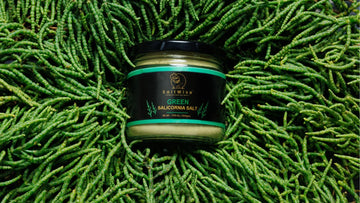
Are you overwhelmed by the different types of salts on the store's shelves? You're not alone. With so many different types of salt available in different colors such as —white, pink, green salt, and different textures such as fine, powdered, flaky, coarse, and even some that look like little rocks—it can be challenging to decide which one is right for you.
But you're not alone in these worries. Many people share your concern about choosing the right salt for their family. Just take your time, read the labels, and keep an open mind about trying new options.
When it comes to choosing Salt for your family, it can be tricky. You want to find a balance between taste and health.
For making a good choice, you must also know about how these different salt choices fit your family's diet.
One of the prime factors to consider is the sodium levels, especially if someone in your family needs to watch their sodium intake.
Plus, there are different textures to consider, from fine table salt to coarse kosher salt and even exotic and gourmet options like green Salt.
To ease your worries, in this blog, we will be exploring different types of salts available in the market. We'll guide you through each variety of salt options, so you can make the best choice for your family's health and culinary needs.
Why is Salt Important in our lives?
Can you imagine a diet without Salt? It would taste pretty bland, right? Salt is really important in our lives for a few reasons. It adds flavor to our meals and helps balance the taste of different ingredients.
But salt does more than just make food taste good. Salt, specifically the sodium and chloride it contains, plays an essential role in the functioning of our bodies. Salt helps control fluid balance, supports nerve and muscle function, and aids in nutrient absorption.
Plus, salt has been used for ages to preserve food, keeping it fresh and safe to eat for more extended periods.
While sodium salt is essential, remember to use it in moderation. The consumption of too much salt and sodium can lead to health problems like high blood pressure. So, remember to enjoy your meals with just the right amount of sodium and choose salt alternatives that are low in sodium, rich in potassium and provide your body with other mineral salts,
Enter the world of different types of Salts:
12 Different Types of Salts:
Here's a list outlining the uses and benefits, origin, Flavor profile and texture of each of the 12 different types of salts:
- Green Salicornia Salt by SaltWise:
Uses: Versatile salt substitute suitable for cooking, baking, seasoning, and as a finishing salts.
Benefits: A plant-based green salt is a perfect salt alternative designed to provide a flavorful and all natural umami punch. This healthy salt alternative to traditional Salt, offers a reduced sodium option while still enhancing the taste of dishes. It is rich in potassium and essential minerals, making it a nutritious and flavor enhancing choice for everyone, including health-conscious individuals.
Origin: It is derived from the Salicornia plant. It is made from 100% dehydrated Salicornia leaves and does not contain any other ingredients or harmful chemicals and substances.
Flavor Profile: Unique blend of taste and nutrition, adding umami kick.
Texture:Flaky
Read More : Benefits of Salicornia Plant
- Table Salt:
Uses: Cooking, baking, seasoning, food preservation, cleaning, personal care.
Benefits: It regulates fluid balance, electrolyte balance, and iodine supply and enhances flavor, food preservation, and hygiene.
Origin: Mined from underground salt deposits.
Flavor Profile: Pure salt taste with added iodine.
Texture: Fine and granular.
- Kosher Salt:
Uses: Cooking, seasoning, curing, rimming cocktail glasses.
Benefits: Larger flakes make it easier to control saltiness, which is ideal for drawing out moisture from meat.
Origin: Harvested from either seawater or rock-salt deposits in salt mines.
Flavor Profile: Less salty taste due to larger crystals.
Texture: Coarse grains.
- Himalayan Pink Salt:
Uses: Cooking, seasoning, brining, bathing.
Benefits: It is rich in minerals, adds a subtle flavor, enhances texture, and may contain trace elements like iron and calcium.
Origin: Mined from ancient sea beds in the Himalayan Mountains.
Flavor Profile: Subtle mineral flavor.
Texture: Coarse crystals with a pink hue.
5.Sea Salt:
Uses: Cooking, seasoning, finishing dishes, bathing, exfoliating.
Benefits: It contains minerals like magnesium and potassium, enhances flavor, adds texture, and may offer slight health benefits over table salt.
Origin: Evaporated from seawater.
Flavor Profile: Varied, depending on minerals present in the water.
Texture: Coarse or fine grains.
- Celtic Grey Sea Salt:
Uses: Cooking, seasoning, finishing dishes.
Benefits: Unrefined, retains minerals like magnesium and calcium, enhances flavor, adds texture.
Origin: Harvested from the Atlantic coast of France.
Flavor Profile: Earthy with a mineral-rich taste.
Texture: Slightly moist and coarse.
- Fleur De Sel:
Uses: Finishing dishes, seasoning, baking.
Benefits: Hand-harvested, delicate flavor, high mineral content, enhances texture.
Origin: Hand-harvested from salt marshes in France.
Flavor Profile: Delicate and slightly briny.
Texture: Light and flaky crystals.
- Pickling Salt:
Uses: Pickling, brining.
Benefits: Fine grain dissolves easily, is free of additives, and prevents cloudiness in pickling liquids.
Origin: Specifically used for pickling.
Flavor Profile: Pure salt taste without additives.
Texture: Fine grains.
- Flake Salt:
Uses: Seasoning, finishing dishes, baking.
Benefits: Thin, delicate flakes dissolve quickly, adding texture and crunch.
Origins: It is often produced through evaporation methods(sea salts or minced salts).
Flavor Profile: Mild taste has a clean and pure flavor.
Texture: Flaky and Flat Crystals.
- Hawaiian Red Salt (Alaea Salt):
Uses: Cooking, seasoning, finishing dishes, roasting.
Benefits: Traditional Hawaiian Salt contains iron oxide, which adds color and flavor.
Origin: Traditional Salt of Hawaii, mixed with volcanic clay.
Flavor Profile: Earthy and slightly sweet.
Texture: Coarse grains with a red hue.
- Kala Namak:
Uses: Indian cuisine, flavouring dishes, vegan cooking.
Benefits: Distinctive sulfurous flavor, aids digestion, may have cooling properties, adds umami kick to dishes.
Origin: South Asia, notably India and Pakistan.
Flavor Profile: Pungent and sulfurous.
Texture: Coarse and granular with a dark color.
- Smoked Salt:
Uses: Cooking, seasoning, grilling, BBQ.
Benefits: Infused with smoky flavor, it adds depth to dishes and enhances grilled meats and vegetables.
Origin: Salt crystals smoked over wood fires.
Flavor Profile: Rich and smoky.
Texture: Varies based on the smoking process.
Different types of salts available in the market, each type of salt offers unique characteristics and benefits, allowing you to choose according to your culinary preferences and dietary needs.
Factors to Consider While Choosing Between Different Types of Salt for Better Health
Now that we know the different types of salts available, it's essential to consider individual needs when choosing salt for optimal health.
Extra deliberation is recommended if you have a health problem that you need to cater for.
Opt for salts with lower sodium content to reduce the risk of high blood pressure and other cardiovascular issues. Explore salt substitutes like Green Salicornia Salt by SaltWise or Himalayan pink salt as alternatives to traditional sodium-based salts.
Choose salts that are rich in essential minerals like potassium, magnesium, and calcium, which offer additional health benefits.
Prefer minimally processed salts, such as sea salt or plant based green salt by SaltWise, over highly refined options like table salt, to get the full benefit of their natural minerals and nutrients. Green salt by SaltWise is made from 100% dehydrated Salicornia leaves, is vegan, gluten free and does not contain any harmful chemicals or additives.
Avoid salts with added iodine, anti-caking agents, or preservatives, as they may have adverse health effects.
Do You Know?
Most Americans consume excessive sodium, which is linked to health problems such as high blood pressure and heart disease. Surprisingly, most dietary sodium comes from packaged and prepared foods rather than table salt. Nutrition Facts labels help you make informed choices about packaged foods to reduce sodium intake. The FDA is collaborating with the food industry to gradually decrease sodium levels in various products, aiming to promote healthier dietary habits and overall well-being.
Decoding Nutrient Claims on Food Packages
Claim: Salt/Sodium-Free
Meaning: Contains less than 5 mg of sodium per serving.
Claim: Very Low Sodium
Meaning: Contains 35 mg of sodium or less per serving.
Claim: Low Sodium
Meaning: Contains 140 mg of sodium or less per serving.
Claim: Reduced Sodium
Meaning: Contains at least 25% less sodium than the regular product.
Claim: Light in Sodium or Lightly Salted
Meaning: Contains at least 50% less sodium than the regular product.
Claim: No-Salt-Added or Unsalted
Meaning: Salt is not added during processing, but these products may not be salt-free otherwise.
These nutrient claims help you quickly identify products with lower sodium content,making it easier to manage your sodium intake for better health. Especially true when considering different types of salt for your dietary needs.
Nutritional breakdown of SaltWise green salt to understand better.
To Sum Up
When it comes to healthier alternatives, consider exploring different types of salt, like SaltWise. SaltWise is a plant based versatile salt substitute suitable for cooking, seasoning, and preserving foods. It offers a reduced sodium option while still enhancing the taste of dishes. Made from 100% dehydrated Salicornia leaves, SaltWise is rich in potassium and essential minerals, making it a nutritious choice for everyone, including health-conscious individuals. So, next time you're shopping for Salt, try SaltWise—it's a flavorful and healthier option for your culinary needs.




